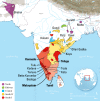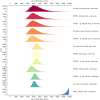A Bayesian phylogenetic study of the Dravidian language family
- PMID: 29657761
- PMCID: PMC5882685
- DOI: 10.1098/rsos.171504
A Bayesian phylogenetic study of the Dravidian language family
Abstract
The Dravidian language family consists of about 80 varieties (Hammarström H. 2016 Glottolog 2.7) spoken by 220 million people across southern and central India and surrounding countries (Steever SB. 1998 In The Dravidian languages (ed. SB Steever), pp. 1-39: 1). Neither the geographical origin of the Dravidian language homeland nor its exact dispersal through time are known. The history of these languages is crucial for understanding prehistory in Eurasia, because despite their current restricted range, these languages played a significant role in influencing other language groups including Indo-Aryan (Indo-European) and Munda (Austroasiatic) speakers. Here, we report the results of a Bayesian phylogenetic analysis of cognate-coded lexical data, elicited first hand from native speakers, to investigate the subgrouping of the Dravidian language family, and provide dates for the major points of diversification. Our results indicate that the Dravidian language family is approximately 4500 years old, a finding that corresponds well with earlier linguistic and archaeological studies. The main branches of the Dravidian language family (North, Central, South I, South II) are recovered, although the placement of languages within these main branches diverges from previous classifications. We find considerable uncertainty with regard to the relationships between the main branches.
Keywords: BEAST 2; Bayesian phylogenetic inference; Dravidian; dating; language phylogeny.
Conflict of interest statement
We declare we have no competing interests.
Figures






References
-
- Hammarström H, Forkel R, Haspelmath M, Bank S. 2016. Glottolog 2.7. Jena, Germany: Max Planck Institute for the Science of Human History.
-
- Lewis MP, Simons GF, Fennig CD. 2016. Ethnologue: languages of the world, 19th edn Dallas, TX: SIL International.
-
- Steever SB. 1998. Gonḍi. In The Dravidian languages (ed. Steever SB.), pp. 270–297. London, UK: Routledge.
-
- Steever SB. 1998. Introduction to the Dravidian languages. In The Dravidian languages (ed. Steever SB.), pp. 1–39. London, UK: Routledge.
-
- Steever SB. 1998. Malto. In The Dravidian languages (ed. Steever SB.), pp. 359–387. London, UK: Routledge.
Associated data
LinkOut - more resources
Full Text Sources
Other Literature Sources
Research Materials
Miscellaneous

